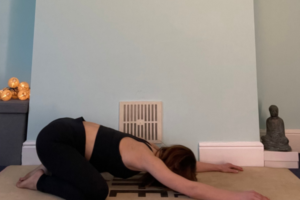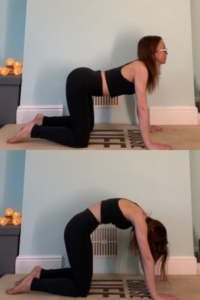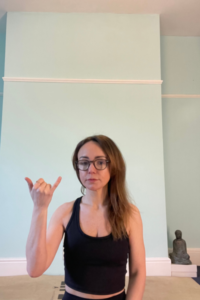Mental Health
5 helpful yoga exercises to reduce anxiety
Anxiety is something that many of us experience throughout our lives, and can become a particular challenge during menopause as a result of fluctuating hormone levels. There are a number of things that we can do to help symptoms of anxiety, however, including practicing yoga.
It’s important to note that anxiety can present itself in a number of ways. From feeling dizzy and struggling to sleep to tightness in the chest and feeling restless, the symptoms of anxiety can be truly wide-ranging and, in some cases, can seriously impact our day-to-day lives.
While there isn’t a one-size-fits-all solution for dealing with anxiety, many people find mindfulness exercises, such as yoga, a helpful way to cope. Here, Alexis Fletcher of Flex Yoga Manchester, shares a mindful ritual of movement, meditation and breathwork to help soothe anxious feelings.
Yoga exercises to reduce anxiety
Step one: movement
Gentle movement – such as yoga or a walk in nature – can be a really helpful way to bring our minds into the present moment.
Try this simple sequence below to help ease anxious feelings. Take the time to focus on how your body feels in each movement, paying attention to your connection with the ground beneath you.
 Child’s pose
Child’s pose
- Come to your hands and knees on your yoga mat, and bring your big toes together behind you. Take your knees almost as wide as your mat.
- Gently move your bottom back towards your heels, bringing your forehead towards the ground and reaching your arms out in front of you, towards the top of your mat.
- Take five steady breaths here.
Tip: make sure your forehead feels supported. If your forehead doesn’t touch the floor, use a cushion or yoga blocks underneath your head. This will help to support your lower back, too.
 Cat/cow
Cat/cow
- From child’s pose, come back to your hands and knees, bringing your wrists under your shoulders and your knees beneath your hips.
- As you inhale, gently begin to arch your spine, lifting your chin and tailbone towards the sky. This is cow pose.
- As you exhale, gently round through the spine, thinking about moving your chin in towards your chest. This is cat pose.
- Repeat this movement four to eight times, focussing on syncing your breath to your movement.
Warrior 1
 After your final cat/cow movement, come to stand on your feet at the top of your yoga mat.
After your final cat/cow movement, come to stand on your feet at the top of your yoga mat.- Take a large step behind you with your right leg, coming into a lunge position. Keep your left toes facing forwards towards the top of your mat.
- Plant your right foot on the mat, taking the toes out at roughly a 40-degree angle. (If this doesn’t feel comfortable for your right knee or hips, stay in a lunge position with your right toes facing forward, standing on the ball of your foot).
- Bend your front leg, taking care that your knee doesn’t go past your toes.
- Inhale and lift your arms overhead. Relax the shoulders.
- Take three to five steady breaths in this postion.
- Step your right foot to the front of the mat, and then repeat the exercise with the opposite leg.
Step two: breathwork
Focussing on our breath can be a helpful method for bringing our attention to the present moment and easing anxious thoughts. Find yourself a comfortable seat, either on the floor or in a chair, and have a go at this breathing exercise.
If at any point you feel uncomfortable, stop the exercise and return to a natural breathing rhythm.
 Alternative nostril breathing
Alternative nostril breathing
- Once sitting comfortably, sit up tall, creating space for your lungs.
- With your right hand, fold down your three middle fingers, leaving your thumb and little finger free.
- Bring your thumb to your right nostril, gently closing it off. Inhale through the left nostril.
- At the top of your inhale, use your right little finger to gently close the left nostril. Pause at the top for one.
- Release your thumb and exhale through the right nostril.
- Inhale once more through the right nostril. At the top of your inhale, close the right nostril off with your thumb once more and pause for one.
- Release your ring finger and exhale through the left nostril.
- This is one round – repeat this process two more times.
- At the end of your third and final round, release your hand from your face and breath naturally through both nostrils.
Step three: meditation
 If you’re feeling more grounded, a gentle meditation can be a really soothing way to finish your practice. Try this savasana after completing your alternate nostril breathing.
If you’re feeling more grounded, a gentle meditation can be a really soothing way to finish your practice. Try this savasana after completing your alternate nostril breathing.
Please note, if you’re feeling particularly overwhelmed or anxious, this may not feel right for you. If you feel uncomfortable at any point, stop the exercise.
- Find a comfortable resting position, for example lying on your back on the ground or on your bed.
- Take a moment to settle your body, making sure you’re comfortable.
- Close your eyes and take a gentle breath in through the nose and a soft sigh out through the mouth.
- Starting at the crown of your head, take a scan around your body, making sure you’re not holding onto any tension. Imagine a wave of softness gently sweeping over each part of your body, all the way to the tips of your toes.
- Allow your mind to focus on your breath, moving in and out of your nose. If at any point you notice your mind wander, gently guide it back to the breath.
- Stay here for five to 10 minutes, or as long as you wish.
- Once you’re ready to finish your meditation, take a few moments to gently wriggle your toes and fingers, before moving into a stretch. Then, open your eyes and sit for a few moments before carrying on with your day.

 Child’s pose
Child’s pose Cat/cow
Cat/cow After your final cat/cow movement, come to stand on your feet at the top of your yoga mat.
After your final cat/cow movement, come to stand on your feet at the top of your yoga mat. Alternative nostril breathing
Alternative nostril breathing



